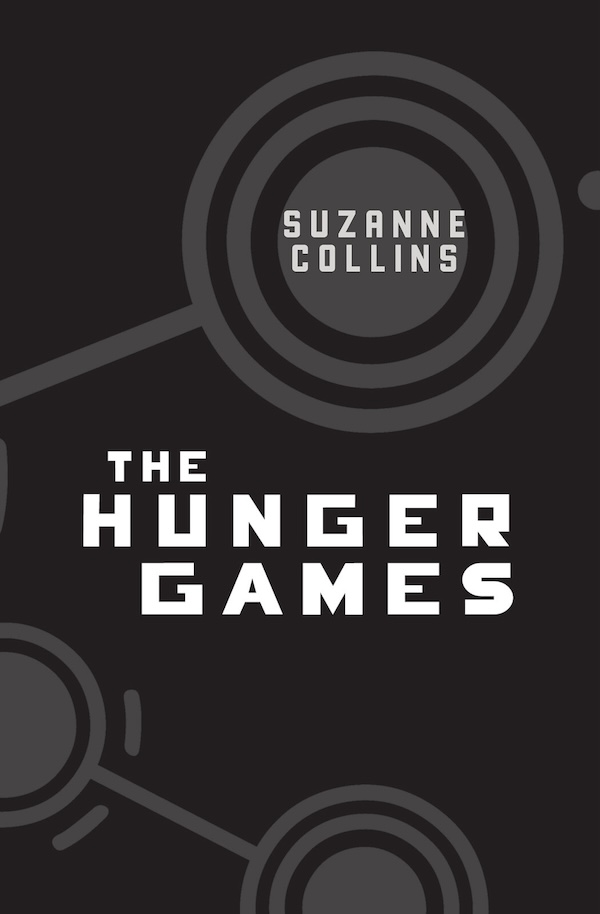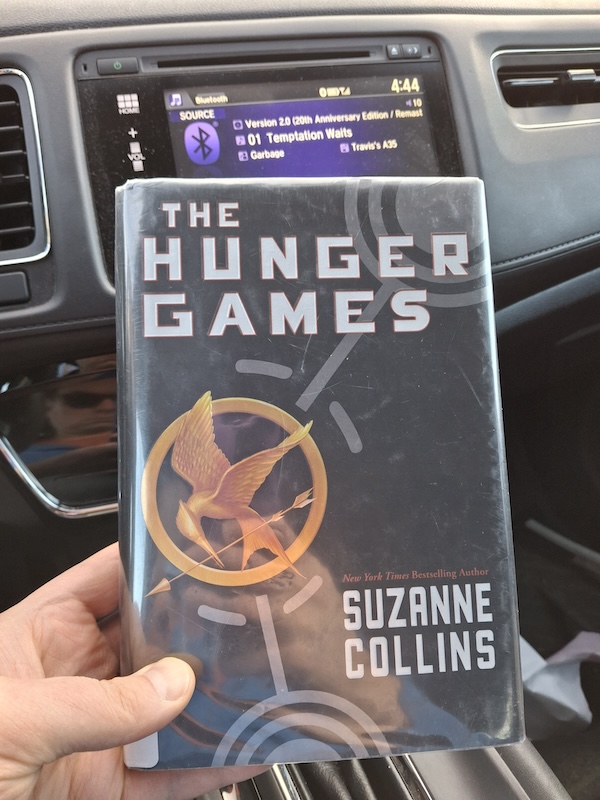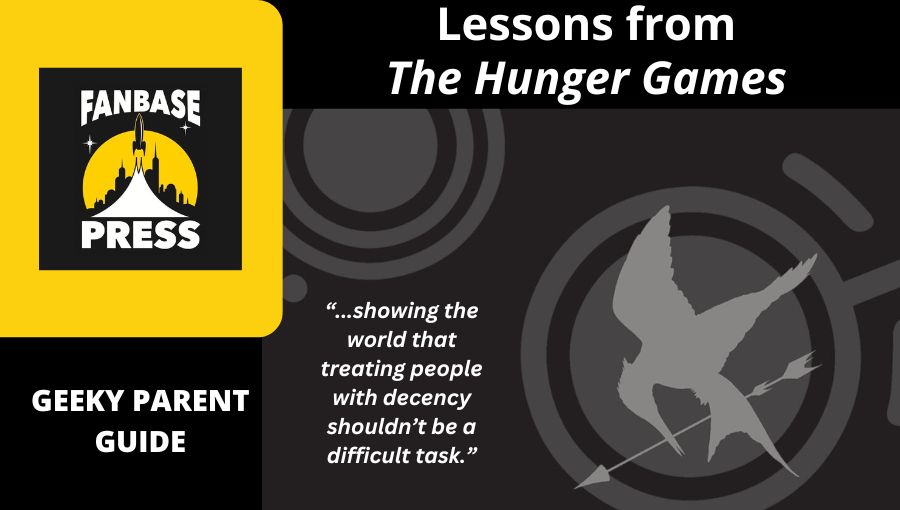The Hunger Games presents several valuable lessons for readers in a bleak dystopian world where young citizens (between ages 12 and 18) of Panem are selected each year to fight to the death. The horrific doom-and-gloom plot is tragic, and author Suzanne Collins places its characters in impossible situations where many things can and do go wrong.
Despite the dreadful living conditions, on top of the yearly threat of being selected, Collins creates a world where a glimmer of hope is presented. With that hope, something miraculous happens in the form of survival, finding ways to help others, and uncertain feelings associated with what appear to be unbreakable bonds. The Hunger Games gives readers a gripping story where the main character, Katniss Everdeen, becomes impossible to not root for, while holding our breath when she finds herself in absolute peril.
So, what lessons can we all take away from this incredible series?
SPOILERS FOR THE HUNGER GAMES BELOW

Standing Up for Others
Some could say that Katniss Everdeen (age 16) didn’t have to volunteer for her sister Prim. Like many others from the twelve districts, people would watch as their siblings were selected for the Hunger Games. It’s a devastating pill to swallow, but Katniss didn’t see any other option. She saw her small, twelve-year-old sister, with her shirt untucked in the back, and the awful death she would succumb to in the Games.
But why was Katniss such an outlier? Why did she volunteer to take her place when so many others stood by and watched? Because in The Hunger Games, life was all about survival, and survival did not happen if you volunteered to the Games – or if you questioned authority. Not only does Katniss put herself in harm’s way, others recognize the gravity of what she’s chosen to do. They honor her by raising their arms with a three-finger salute.
A small gesture, perhaps, but one that unified a group to recognize the bravery of one teenager to do something so simple and stand up for her little sister. In raising their arms in support of Katniss, this small spark of unity eventually spreads through to other districts. While in the game, Katniss’ alliance with Rue saw support from District 11, despite Rue being killed by the time they sent her food. Again, a group recognizes the strength of this one person to “join forces” by sending food.
A loaf of bread might not seem like a monumental sign of standing up to tyranny, but Rue’s district chose to honor someone from another district: a person fighting to survive, even in the face of another District 11 member (Thresh) still active in the Hunger Games. It’s a valuable lesson for kids to recognize coming together, standing side by side with others, and showing the world that treating people with decency shouldn’t be a difficult task.
Did the story end after one book? No, but it’s also important for kids to understand that doing the right thing doesn’t mean that change happens overnight. Katniss and Peeta both became “Victors” during the 74th Hunger Games, but the cost was incalculable. Beyond the atrocities of being stuck in an arena where murdering one another is required, how many people starved to sponsor something as simple as a loaf of bread? The cost of goods increased exponentially the further into the game each tribute lasted.
So, even though they come from different districts and backgrounds, it doesn’t mean people cannot recognize the value of supporting others. Young adults who read this story will see how those who have little can still make an impact. Living in Panem (or the real world) doesn’t have an “easy button,” and sometimes, depending on or supporting one another is the best way to move forward.

Feelings Are Complicated
Something that kids, teens, and adults can all agree on: It is not always easy to figure out our feelings. Katniss is a teenager who is thrown into a yearly death battle, which is difficult to process on its own. But she’s given a “love story” to lean on to gain sponsorships while in the Games. Does Peeta love Katniss even though it’s created for the cameras? Yes, but he also has to decipher whether or not Katniss truly feels something for him.
Katniss plays her role in the games, taking cues from their mentor Haymitch, and tries to maximize their relationship. She also finds herself committed to Peeta in a way where bonds of attachment do form. It would be difficult to resolve this situation as an adult, but Katniss and Peeta are still trying to understand the depths of who they are, let alone what it means to care and love for another person at such a young age.
Surrendering yourself to volunteer for your sister is one thing, and completely understandable. Knocking a person out with sleeping syrup so you can risk your life to get them the medicine they need; well, that’s another thing entirely. Katniss has to navigate what it means to risk her life for someone who confessed their love for her, and then appeared to side with other tributes to find and kill her, to then realize all of what Peeta did was to protect her.
Sometimes, our kids will be solemn and have days where they just don’t want to go to school. Some days they will be silly, make faces, and create goofy sounds. Kids, teenagers, adults – we’re all vulnerable to a variety of different situations where feeling overwhelmed, confused, elated, hungry, anxious, or any combination leads to any given day being handled differently. Katniss struggled to survive starvation, so imagine how difficult it would be to function without food, and what that feeling might be for someone who knows tomorrow might present the same absence.
Not everyone experiences the same feelings on the same day. Much like Katniss didn’t know about Peeta’s feelings for her, it’s important that kids (and adults) understand that everyone has their own reality to deal with on a daily basis. Everyone has ups and downs, but more importantly, it’s a necessary tool to recognize that we don’t always know whether or not a person is up or down on any given day. But if we teach our kids to be understanding, then maybe they will be viewed as a friend when another person needs to open up about their struggles.

Why Should Parents & Their Teens Should Read The Hunger Games
The Hunger Games by Suzanne Collins presents an idea of perseverance that’s greatly needed in life. It feels impossible to avoid days where it just seems like a “bad day” or that everything in the world looks grim. Katniss and Peeta live in a world where starvation is a fact. Harsh punishments for small things are a reality in Panem. Being offered as tributes to the Hunger Games as a reminder of non-living “crimes” seems like an outrageously unfair reality.
Unfortunately, the real world does not shy away from outrageously unfair realities. It’s important that kids and their parents find ways to recognize good actions from evil ones, kind people from malevolent, and ultimately finding a path to form bonds where the main goal is to look out for one another, even in the face of hate and bigotry.
The Hunger Games presents a world where Peeta, as a young boy, saw Katniss, as a young girl, and could not let her suffer in the cold rain, possibly to die there in the streets. He tossed her loaves of burnt bread without saying a word. He was punished for burning the bread, but he knew that doing something for someone in need was the right thing to do.
Much like District 11 sending Katniss bread in the arena, one small act of kindness can make the difference in someone’s life. In a world where the atrocities seem endless, one small good action can help. If we don’t learn anything else, helping others is sometimes what we need in the real world.
Until next time, happy parenting, happy geeking, and may we all support each other with a loaf of bread.
The Hunger Games
Author: Suzanne Collins
Publisher: Scholastic
Ages: 12 – 18
Grades: 7 – 12
If you’re not interested in purchasing The Hunger Games, or you have enough books on your shelves already, I would recommend checking out your local library. My family uses our local library, as it is a wonderful resource to check out books, movies, games, or find quiet spaces to read or work on projects.

